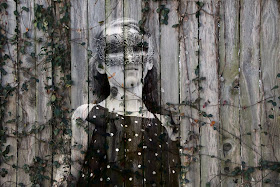So, I wanted to make some felted wool slippers and I struggled
to find a pattern for something I liked. I did find a lovely pattern for a pair
that was made pretty much like an oversized anklet sock but though they shrank
lengthwise they were like 3 or 4” too big around. (The cat loves them and
sleeps on them every day.) They have already gone through the felting process twice so I am not sure if they will shrink around much more.
The blue slipper is the size the gray pair started out at before being felted. They felted beautifully but are way too big around.
After making those and having such bad luck I came up with
this clog version. Love them! They are quick and easy, worked flat, and make me
happy.
Sorry about the photos. This new place has horrible lighting
for photo taking and I have no room to set up a studio area. Despite the bad
photos, I think you can see how cute and cozy these felted slippers turned out.
This is my pattern:
Clog Style Felted Knit Slippers
Size 11 knitting needles (I used 24” circulars but they
should work on straight needles also.)
Worked flat
Gauge = 3 sts per 1” and 3 rows per 1” in stockinette
Patton’s Wool
You can make these with 1 skein each of the two colors for
the single stranded version but for the two strand version I recommend having 2
skeins each of the two colors. It makes it so much easier to work with two
strands at the same time from two different skeins.
CO 39
R1: Knit 39
R2: K1, KFB, K , KFB, Place Marker, K1, Place Marker,
KFB, K , KFB, K1
R3: Knit (knit all odd rounds)
R4: K1, KFB, K to 1 st before M, KFB, K3, KFB, K to 2 st
before end, KFB, K1
K6: K1, KFB, K to 2 st before M, KFB, K5, KFB, K to 2 st
before end, KFB, K1
R8: K1, KFB, K to 3 st before M, KFB, K7, KFB, K to 2 st
before end, KFB, K1
R10: K2, KFB, K to 4 st before M, KFB, K9, KFB, K to 3 st
before end, KFB, K2
R12: K2, KFB, K to 5 st before M, KFB, K11, KFB, K to 3
st before end, KFB, K2
Sole should measure about 6” x 12-13” and be 59 st on
needles.
If you want these to be bigger you can do another knit
round and then repeat round 12 to have 63 sts on needles.
Change color
R13: Knit 59 st
R14: Purl 59 st
R15: Knit to 1 st past second marker, turn, sl 1, P4,
turn, sl 1, K3, ssk, K1, turn, sl 1, K5, ssk, K1, turn, sl 1, P6, P2 tog, P1,
turn, sl 1, K7, ssk, K1 continue working the short rows until you reach the
ends.
Slipping 1 will
bring yarn to working position and the decreases will close the gaps caused by
turning. Just always knit or purl together the gaps as you encounter them and
work one K or P st past the decrease and eventually you will reach the ends.
K16, 17: Knit a row and purl a row then bind off the 31
(35) sts.
Seam the back few rows. Felt!
There are many ways to felt but I find what works the
best for me is top loading washer with a few items to be felted and an old pair
of jeans washed on hot with a normal load sized amount of laundry soap.
I made a pair with single stranded yarn and also a pair
with two strands of yarn. The single strand of yarn felted up nicely and was
the right size after one round through the washer but is definitely a thinner
fabric. The double stranded pair is nice and thick but one round through the
washer was not enough to felt it down to the right size. I can wear them with
my thick SmartWool socks but they could be a size smaller. Another round in the
machine should do the trick.
I LOVE these slippers. They are so WARM and comfortable.
And darling, adorable to look at.
I wear a size 7-8 1/2 depending on the shoe style but you can control (sort of) the sizing with the felting process. For an average size 8 make the sole the 59 sts and for size 9-10 do another row with increases for a total of 63 sts. For smaller sizes, 5-6 stop at 55 sts for the sole. The upper part will be worked the same because it's just short rows worked across what's available.
I wear a size 7-8 1/2 depending on the shoe style but you can control (sort of) the sizing with the felting process. For an average size 8 make the sole the 59 sts and for size 9-10 do another row with increases for a total of 63 sts. For smaller sizes, 5-6 stop at 55 sts for the sole. The upper part will be worked the same because it's just short rows worked across what's available.
Single stranded version.
Two strand version.
I am walking on carpet so I have not had any issues with
being slippery but if you have wood floors or maybe tile, you can sew some
scrap leather on the bottom for traction or those glue dots for grip.
Wool felting shrinks more height-wise than it does
width-wise. (Over rows vs over stitches.) A good formula I found:
Felting good dense fabric:
Stitches (desired size) x 1.2 = pre-felted size
Rows (desired size) x 1.42 = pre-felted size
Felting very dense fabric:
Stitches (desired size) x 1.43 = pre-felted size
Rows (desired size) x 1.78 = pre-felted size





















































